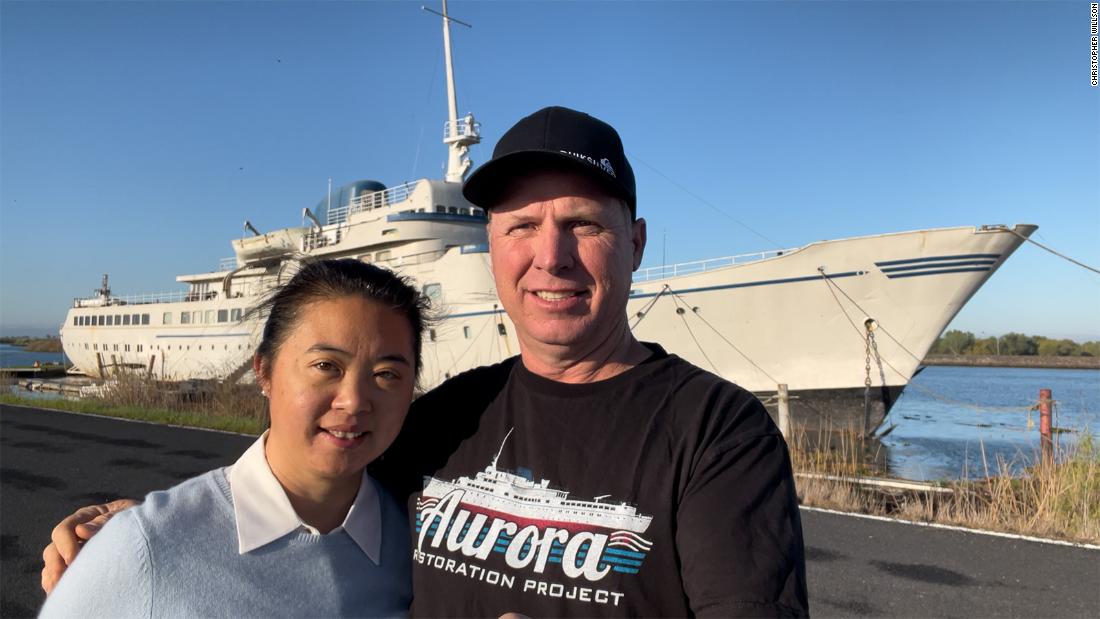(CNN) — It’s not every day that you spot a cruise ship for sale on Craigslist. So Chris Willson was immediately intrigued when he stumbled across a 293-foot vessel listed on the classified advertisements website back in 2008.
The retired “pocket” cruise ship, built in Germany, was moored in the California Delta at the time, and its then owner was keen to offload it.
After seeing the listing pop up numerous times Willson, who was working on developing virtual reality tours, decided to do some investigating.
“I kind of posed as a potential buyer, even though I really didn’t have any interest in purchasing a ship,” Willson tells CNN Travel. “It was a little out of my comfort level, to say the least.”
Once he made the trip down to the inland river delta and estuary in Northern California and stepped onboard, Willson was struck by how badly the 2,496 gross ton ship had been neglected over the years.
However, as he began to explore further, he realized that there was a pretty impressive five-level vessel beneath all the “junk” on board.
Sealing the deal
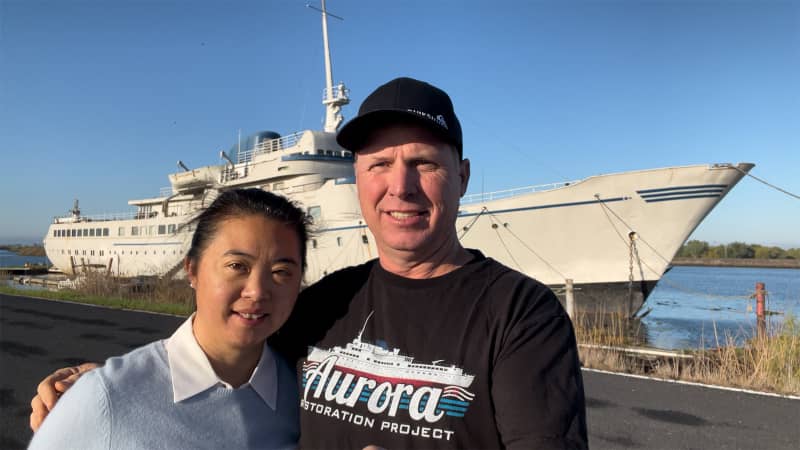
Chris Wilson and his partner Jin Li now live on board the cruise ship he bought in 2008.
Christopher Willson
“She has one of the most spectacular layouts of just about any ship I’ve seen,” he adds. “The staircases are magnificent.
“It’s almost the same as if you found an old 60s Corvette in the garage. You can see the quality is there, but it’s so neglected, you almost feel bad for it.”
After doing some digging into the background of the ship, he discovered that it was constructed by the Blohm and Voss shipyard in 1955, and had been the first significant passenger liner built by Germany after World War II.
The more he learned about the ship, which was originally named Wappen von Hamburg, the more convinced he became that this was a project he was willing to take on.
After carefully considering the enormity of what it would mean to own a mini cruise ship, Willson put together a restoration plan and decided to take the plunge.
While he’s loath to discuss the amount he paid, he says he was able to “work out a really good deal with the owner of the vessel.”
“The next thing you know, I own a ship,” Willson adds.
But once he’d signed on the dotted line, he had to figure out where he was going to put it. Thankfully, Willson was able to secure a lease in the California river city of Rio Vista and arranged for the ship to be towed there.
Passion project
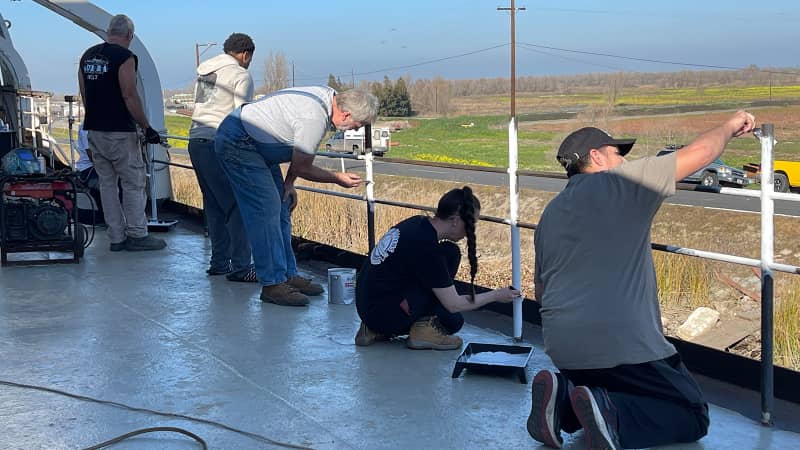
Willson has been working on the ship, which is moored at a marina in Little Potato Slough, California, with the help of volunteers.
Christopher Willson
That’s when the restoration process began. The first step was getting rid of all of the trash on board — Willson says there were hundreds of bags worth of household type garbage along with old mattresses and blankets — and setting about finding volunteers to help.
“I figured it was going to be a long project,” says Willson. “The scale of it was massive. It’s almost the same as redoing 15 houses all by yourself.”
After spending a few months traveling for around three hours from his home in Santa Cruz to work on the ship, Willson decided to move on board with his partner Jin Li so that he could fully focus on the project, as well as keep it secure.
“When I first moved aboard many of my friends and family were in disbelief,” he admits. “It was a rather large change in lifestyle. “But I view it as more of an upgrade, although we are off grid and running on mainly generators and solar grids.”
As he began digging further into the history of the ship, Willson says he learned that, not only had it been the inspiration for popular TV series “The Love Boat,” it was also the filming location for the Spectre criminal organization headquarters in the 1963 James Bond movie “From Russia with Love.”
The vessel served as a cruise ship for around two decades, he says, and went through several different owners, as well as names, before being moored in Vancouver.
After a few false starts and more ownership and name changes, it was towed to Alameda, California in 2005. Plans were put in place to turn it into a luxury yacht, but they ultimately fell through.
The ship remained at Alameda for several years until it was bought by a businessman and moved to the California Delta. The vessel was thought to be on the verge of being scrapped when Willson saw it advertised on Craiglist in 2008.
Historic vessel
“The more I learned about the history, I was thinking that it could be a shore side attraction, kind of like the Queen Mary [a retired ocean liner moored at Long Beach that’s now a popular tourist attraction],” he explains. “I’d like to make a museum out of it and let people do tours [of the ship].”
He estimates that it would cost around $3 million to transform the vessel into a shoreside attraction.
Willson, who had no prior experience working on ships, has spent around 14 years renovating the ship, with the help of volunteers.
“I’m pretty crafty,” he says, explaining that he’d rebuilt lots of cars in the past and previously worked as an electrical mechanical engineer doing disaster recovery.
He renamed the vessel the Aurora after spending his first night on board.
“I woke up to one of the most brilliant sunrises I had ever seen,” Willson explains. “It was forming an Aurora type effect with the clouds and water. I remember thinking at that time ‘Aurora’ was a fitting name.”
With the help of volunteers, along with Li, who Willson says has played a key role in helping to preserve the Aurora, he’s completed renovations on some of the passageways, as well as a lounge and a number of cabins.
“Our biggest achievement has been removing the old wood from the decks and spending a massive amount of time welding in new steel plates to completely seal the decks,” he says.
“It’s not so much the working on the ship that’s the biggest challenge, it’s dealing with the politics behind it. Does the county or the city want your ship there?”
After a few years in Rio Vista, Willson was offered a berth in San Francisco’s Pier 38 and moved the Aurora there. However, things didn’t work out as he expected and Willson was later asked to find a new home for the ship.
He had it transferred back to the California Delta in 2012, mooring the Aurora at a marina in Little Potato Slough, located around 24 kilometers from the city of Stockton in California’s Central Valley.
Aurora has been stationed “in fresh shallow water” here ever since and looks set to remain for the foreseeable future.
Although the ship is unable to sail, Willson stresses that it has a “solid bottom,” and after consulting with a number of maritime engineers, he’s confident that, “with proper maintenance and supervision,” it can safely remain where it is.
“As long as we don’t take it out where there’s a lot of electrolysis and things like that,” he adds. “She is safe for the time being but we have plans to move her closer to the bay when she is further along in her restoration.”
He hopes to raise enough funding to pull the ship out of the water and redo the underside at some point.
Raising funding
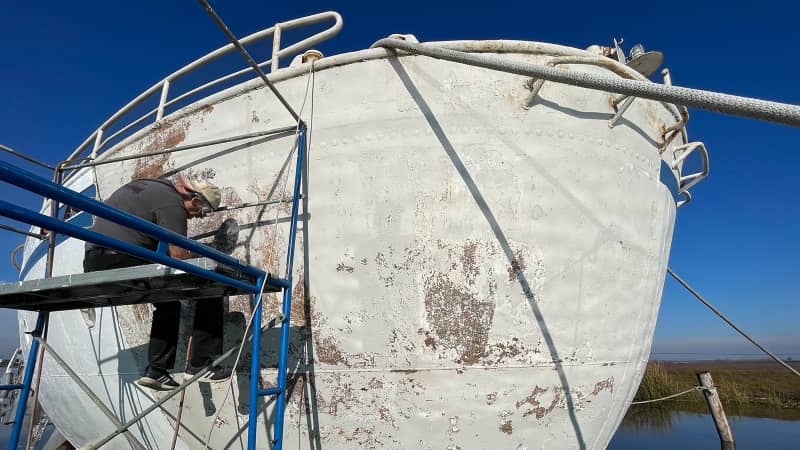
Willson has funded the bulk of the work himself, but hopes to raise enough funding to transform it into a museum.
Christopher Willson
“As far as actually working on the ship goes, I’ve learned so much,” he says. “There’s nothing I don’t know how to fix. But it all takes a bunch of money to get there.”
Aside from a few small donations, Willson has funded the bulk of the renovation work himself so far.
He’s been able to raise finances for the work by buying items from flea markets and state auctions and reselling them on online auctions sites like eBay, as well as working as a consultant on other historic vessel projects.
But while this income has kept the project going so far, it’s certainly not enough to fund the full restoration, and Willson is determined to finish what he started.
“Since the whole YouTube thing came about, we have had hundreds and hundreds of people offering to volunteer,” he says.
Willson is hopeful that its success will help to speed things up, and says he’s already seeing results.
“Things are picking up very fast,” he says.
However, producing videos alongside renovating a ship is proving to be tricky, and he’s still “finding his feet,” when it comes to juggling both.
“Once I start getting more comfortable with that, we’ll hopefully start having groups of volunteers coming in several days a week,” Willson adds.
Completion in sight?
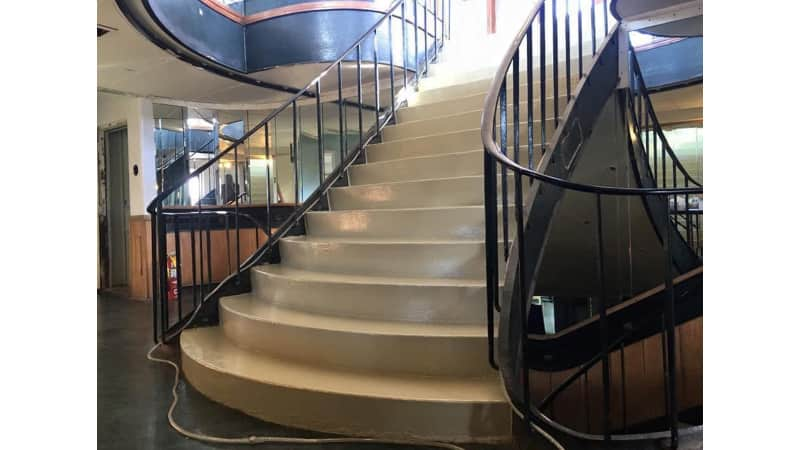
A grand staircase aboard the ship, which Willson has renamed the Aurora.
Christopher Willson
Although there’s still quite a way to go, Willson is slowly moving closer to his goal of transforming the Aurora into a museum.
While he’s also thought of transforming the ship into a bed and breakfast, or even a wedding venue, he feels that a museum is the most “realistic” option.
“This is something that we’re trying to give back to the people,” he says. “We don’t want to fix it up and make our own private yacht out of the thing.”
And there’s certainly a lot to view on board the Aurora. The ship contains 85 cabins, as well as an upper lounge with its own private large forward deck, a swimming pool, a large galley and a theater.
“We have restored a small number of cabins aboard but have many, many to go and will soon offer the opportunity for the public to sponsor the restoration of a cabin,” he says.
Willson and his team of volunteers are currently working on the fantail, or rear, of the Aurora and aim to fully restore the galley and dining area throughout the rest of 2022.
In recent years, Willson has received furniture from other historic ships to use on board the Aurora.
“We had a large donation from the Island Princess, one of the ships they actually filmed the ‘The Love Boat’ on, which was just recently scrapped,” he says.
For the time being, Willson is enjoying working and living on board the ship and looks forward to the day that he’ll be able to open it up to the public.
“There’s really nothing more spectacular than being able to work on and live on something this unique,” he adds.
But does he hold out any hope that this spectacular vessel may set sail again one day?
“If the money comes in, she can be made to cruise again,” he says. “If it doesn’t, she can be a great museum.”
